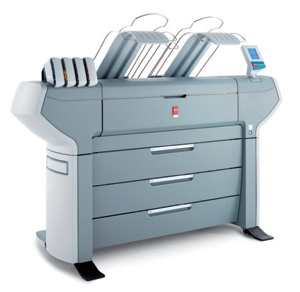ItÝs not often a new print technology comes along and certainly not one that promises so much. CrystalPoint from Oc? is being seen by many as the future of wide format colour printing, a bold statement for a technology that distributes its ink by rolling balls down a chute. By Greg Corke.
OceÝs new CrystalPoint technology is designed to bridge the gap between LED and inkjet, offering full colour output at speeds never seen before. It has been in development for over 10 years at an estimated cost of ?150 million. With that kind of money behind it and with a company the size of Oc? at the reins, CrystalPointÝs unveiling last month in Venlo sent ripples through the wide format print industry.
CrystalPoint technology is not dissimilar to inkjet insofar as it jets tiny droplets of ink (gel) on to paper. But unlike the de-facto wide format colour standard, which needs specialist coated paper, it does this onto plain paper.
Instead of ink or powder-based toner, CrystalPoint uses solid colour toner balls made out of resin. Each TonerPearl is about the size of a small marble and is delivered to the imaging device by rolling down a delivery chute. When each TonerPearl reaches the imaging device it is heated and turns into a toner gel, which is then jetted onto the plain paper in tiny droplets much like an inkjet. However, unlike standard inkjet ink, Oc?Ýs TonerPearls include a special agent, which crystallises once it has adhered itself to the media. The result is an instant dry print with a stronger bond and a semi gloss silk finish. Prints are also waterfast, which makes them ideal for use on site.
Oc? ColorWave 600
CrystalPoint is the technology, but the first product to come to market is the ColorWave 600, a 42-inch (A0+) capable wide format printer with a price tag from ú30,000. It delivers a single colour linework A0 drawing in a breathtaking 31 seconds, which is about twice as fast as a top-end inkjet, though Oc? says it really comes into its own in terms of throughput when delivering full colour prints.
Backing up this raw print speed, the ColorWave 600 is all about production level printing. It has capacity for six media rolls, each containing up to 200 metres of plain paper and four 500g TonerPearl cartridges (CMYK), which sit in clear cartridges on the top of the machine. A top mounted delivery tray has capacity for 100 prints and an optional folder and stacker are borrowed from OceÝs volume monochrome devices.
In terms of job delivery, Oc?Ýs new Print Assistant software helps choose the correct print mode by analysing each job as it is sent and adjusting the settings for draft, production, or presentation. In terms of quality, there is very little between linework prints in draft and presentation mode, so this is a useful way to enforce ink savings.
Print quality
When compared with a typical inkjet, the ColorWave 600 does not offer the same level of print quality, but it is still good. While linework is excellent, the output colours on renderings or photographs lack a little vibrancy.

However, inkjet technology sets incredibly high standards and to achieve best results you need to print on photo quality paper. It shouldnÝt be forgotten that the ColorWave 600 uses plain paper and the silk finish, which means there are no reflections under bright office lighting, will also appeal to many users.
For the past decade and beyond, the technical wide format printing market has been served by two core technologies, inkjet and LED. Colour inkjet is great for producing photo quality prints but it is relatively slow so not ideally suited to a production environment. It also requires special coated paper for best results. LED, on the other hand, delivers incredibly sharp prints on plain paper. It is also extremely quick with some machines churning out over ten A0s per minute. The downside is that it does this in monochrome only.
OceÝs CrystalPoint looks to offer the best of both worlds ± production level printing in full colour. It is not up there with LED in terms of speed, but the benefits of full colour shouldnÝt be underestimated in terms of its ability to communicate designs.
For years engineers and designers have sacrificed colour for throughput. With OceÝs CrystalPoint thereÝs now a platform on which to find the middle ground and while the first generation product doesnÝt quite tick all the boxes when it comes to speed and quality, itÝs certainly a groundbreaking technology and one which will be extremely interesting to track in the coming years.






